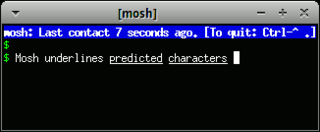Related Research Articles
The Secure Shell Protocol (SSH) is a cryptographic network protocol for operating network services securely over an unsecured network. Its most notable applications are remote login and command-line execution.

An email client, email reader or, more formally, message user agent (MUA) or mail user agent is a computer program used to access and manage a user's email.
The File Transfer Protocol (FTP) is a standard communication protocol used for the transfer of computer files from a server to a client on a computer network. FTP is built on a client–server model architecture using separate control and data connections between the client and the server. FTP users may authenticate themselves with a plain-text sign-in protocol, normally in the form of a username and password, but can connect anonymously if the server is configured to allow it. For secure transmission that protects the username and password, and encrypts the content, FTP is often secured with SSL/TLS (FTPS) or replaced with SSH File Transfer Protocol (SFTP).

In computer networking, a proxy server is a server application that acts as an intermediary between a client requesting a resource and the server providing that resource. It improves privacy, security, and performance in the process.
SOCKS is an Internet protocol that exchanges network packets between a client and server through a proxy server. SOCKS5 optionally provides authentication so only authorized users may access a server. Practically, a SOCKS server proxies TCP connections to an arbitrary IP address, and provides a means for UDP packets to be forwarded. A SOCKS server accepts incoming client connection on TCP port 1080, as defined in RFC 1928.

Virtual Network Computing (VNC) is a graphical desktop-sharing system that uses the Remote Frame Buffer protocol (RFB) to remotely control another computer. It transmits the keyboard and mouse input from one computer to another, relaying the graphical-screen updates, over a network.
RealVNC is a company that provides remote access software. Their VNC Connect software consists of a server and client application, which exchange data over the RFB protocol to allow the Viewer to control the Server's screen remotely. The application is used, for example, by IT support engineers to provide helpdesk services to remote users.
Secure copy protocol (SCP) is a means of securely transferring computer files between a local host and a remote host or between two remote hosts. It is based on the Secure Shell (SSH) protocol. "SCP" commonly refers to both the Secure Copy Protocol and the program itself.

A shell account is a user account on a remote server, typically running under Unix or Linux operating systems. The account gives access to a text-based command-line interface in a shell, via a terminal emulator. The user typically communicates with the server via the SSH protocol. In the early days of the Internet, one would connect using a modem.

In computer networking, port forwarding or port mapping is an application of network address translation (NAT) that redirects a communication request from one address and port number combination to another while the packets are traversing a network gateway, such as a router or firewall. This technique is most commonly used to make services on a host residing on a protected or masqueraded (internal) network available to hosts on the opposite side of the gateway, by remapping the destination IP address and port number of the communication to an internal host.
In computer networks, a tunneling protocol is a communication protocol which allows for the movement of data from one network to another. It can, for example, allow private network communications to be sent across a public network, or for one network protocol to be carried over an incompatible network, through a process called encapsulation.
NX technology, commonly known as NX or NoMachine, is a remote access and remote control computer software, allowing remote desktop access and maintenance of computers. It is developed by the Luxembourg-based company NoMachine S.à r.l.. NoMachine is proprietary software and is free-of-charge for non-commercial use.
An SSH client is a software program which uses the secure shell protocol to connect to a remote computer. This article compares a selection of notable clients.
In the X Window System, programs run as X clients, and as such they connect to the X display server, possibly via a computer network. Since the network may be accessible to other users, a method for forbidding access to programs run by users different from the one who is logged in is necessary.
HTTP tunneling is used to create a network link between two computers in conditions of restricted network connectivity including firewalls, NATs and ACLs, among other restrictions. The tunnel is created by an intermediary called a proxy server which is usually located in a DMZ.
Web-based SSH is the provision of Secure Shell (SSH) access through a web browser. SSH is a secure network protocol that is commonly used to remotely control servers, network devices, and other devices. With web-based SSH, users can access and manage these devices using a standard web browser, without the need to install any additional software.

OpenSSH is a suite of secure networking utilities based on the Secure Shell (SSH) protocol, which provides a secure channel over an unsecured network in a client–server architecture.
A jump server, jump host or jump box is a system on a network used to access and manage devices in a separate security zone. A jump server is a hardened and monitored device that spans two dissimilar security zones and provides a controlled means of access between them. The most common example is managing a host in a DMZ from trusted networks or computers.
Internet censorship circumvention, also referred to as going over the wall or scientific browsing in China, is the use of various methods and tools to bypass internet censorship.

In computing, Mosh is a tool used to connect from a client computer to a server over the Internet, to run a remote terminal. Mosh is similar to SSH, with additional features meant to improve usability for mobile users. The major features are:
References
- ↑ Danen, Vincent (2009-10-05). "Using Corkscrew to tunnel SSH over HTTP". TechRepublic . Retrieved 2024-02-04.